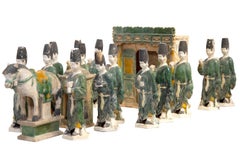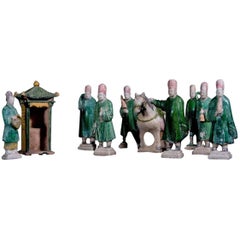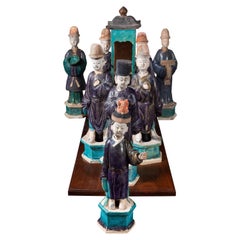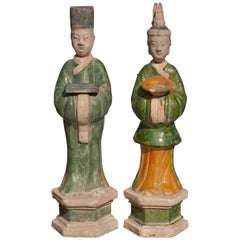Ming Dynasty Procession
15th Century and Earlier Ming Figurative Sculptures
Ceramic
Antique 15th Century and Earlier Chinese Ming Antiquities
Terracotta
Recent Sales
Antique 17th Century Chinese Ming Sculptures and Carvings
Terracotta
Antique 16th Century Chinese Ming Figurative Sculptures
Terracotta
Antique 18th Century and Earlier Chinese Sculptures
Pottery
People Also Browsed
Vintage 1970s Norwegian Scandinavian Modern Swivel Chairs
Velvet, Bentwood
Antique 15th Century and Earlier African Natural Specimens
Bone
20th Century Floor Lamps
Glass
Antique Late 19th Century Unknown Biedermeier Sofas
Fabric, Mahogany
Antique 19th Century Chinese Qing Console Tables
Wood
Antique 19th Century Syrian Cabinets
Wood, Walnut
Vintage 1930s French Art Deco Decorative Boxes
Silver
Vintage 1920s French Art Deco Desks and Writing Tables
Amboyna
Mid-20th Century Danish Scandinavian Modern Sofas
Leather, Mahogany
Antique Early 19th Century Mongolian Furniture
Wood
Antique 1770s English Chinese Chippendale Armchairs
Suede, Mahogany
2010s American Modern Ottomans and Poufs
Cotton, Wood
Early 20th Century American Art Deco Cabinets
Oak
Vintage 1920s English Art Deco Picture Frames
Sterling Silver
Antique 1890s Indian Anglo-Indian Wall Mirrors
Sandalwood
Vintage 1940s American Art Deco Musical Instruments
Chrome
A Close Look at Ming Furniture
In what’s considered a golden age of Chinese furniture, Ming dynasty artisans produced expertly made designs that married elegance and function. Ming furniture was versatile, such as tables that doubled as writing desks and dining spaces. But it was also beautiful, enhancing a room with clean lines, soft curves and sophisticated decoration.
Dating from 1368 to 1644, the Ming dynasty was a vibrant time for international trade and culture. Especially for scholars and the wealthy, there was an emphasis on a home’s design to promote a good life. From large wardrobes to angular sofas, Ming-style furniture was defined by its joinery, which, instead of nails, involved meticulously designed interlocking elements of wood. This material was carefully selected and positioned to make the grain part of the design. The slow-growing huanghuali, a yellowish rosewood, was particularly valued for its bright color.
Although ornamentation was minimal, Ming dynasty furniture often featured carved or painted details of flowers, insects, dragons, fruits and other motifs. Chairs crafted for scholars could include calligraphic brush writing. As overseas trade expanded, techniques from the West, like cloisonné enamel painting, adorned table screens and other pieces.
Ming furniture influenced styles abroad such as Queen Anne in England and Hollywood Regency in the United States. The curved shape of Ming armchairs had a profound impact on legendary Scandinavian modernist furniture designer Hans Wegner. The Danish cabinetmaker shared the Ming artisans’ interest in creating streamlined, functional furnishings, and his China chair, Round chair and Wishbone chair are inspired by Ming dynasty seating. Today, the Ming-style horseshoe chair is a graceful and sought-after type of seat, and contemporary Chinese designers such as Jerry Chen and Gan Erke are also drawing on this heritage for a new era of style.
Find a collection of Ming cabinets, decorative objects, lounge chairs and other furniture on 1stDibs.
- 1stDibs ExpertNovember 4, 2024To identify Ming dynasty furniture, first check the legs, back, undersides and other inconspicuous areas to see if you can locate any maker's markings. If you do, snap a photo with your phone and perform a reverse image search. You may be able to determine the maker and year of production. The Ming dynasty lasted from 1368 to 1644 in China. Furniture from this time period often features natural woods and shows off simple lines. Because artisans working during the era typically used mortise and tenon joinery, authentic Ming Dynasty furnishings will usually not have any visible nails or screws. However, there are many convincing reproductions on the market, so experts generally recommend having a certified appraiser or knowledgeable antique dealer perform the identification process for you. Shop a collection of Ming dynasty furniture on 1stDibs.
- 1stDibs ExpertOctober 19, 2021A Ming dynasty vase is going to be worth a lot. In 2021, a blue and white Chinese bowl was bought at a yard sale in Connecticut that turned out to be a rare Ming dynasty-era ceramic work. It is estimated to be valued at between $300,000 and $500,000. Shop a range of antique and vintage vases on 1stDibs.



